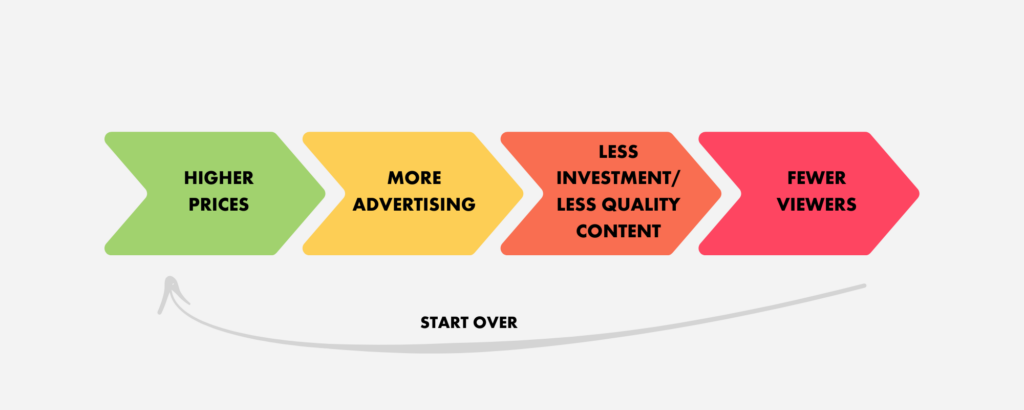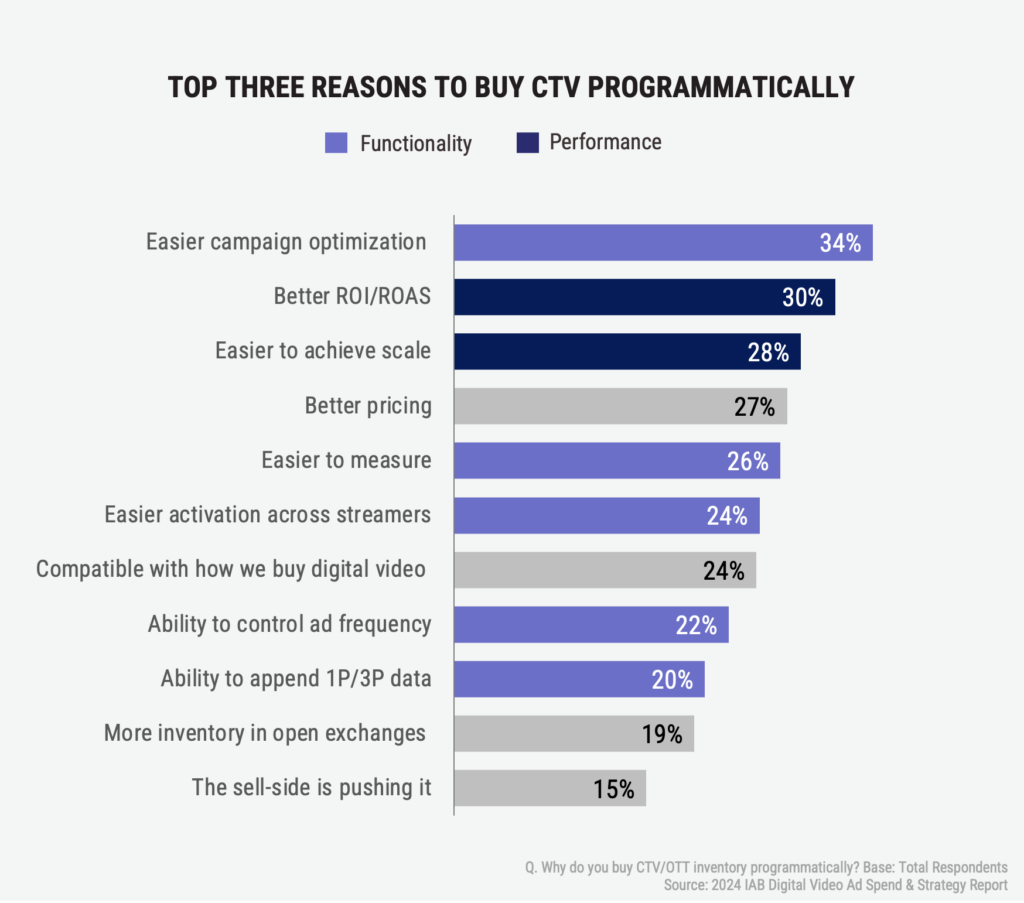This is a CTV summer blog series discussing the Streaming Business Model, CTV Programmatic Buying, and CTV Frequency management. Every month, one new article is released. Follow along and join the discussion!
In the first blog post of this CTV summer blog series, we discussed the streaming business model and the current doom loop of challenging profitability:

From the advertiser’s point of view, this might lead to consolidation, less choice, less competition, and potentially higher prices.
As this reality unfolds, tension arises regarding the best way to build reach. Should a marketer build reach through broad target audiences or niche content? In today’s marketplace, marketers can no longer deliver reach through water cooler shows as they did in the past – these shows simply don’t reach mass audiences (except for large sporting events). We live in a world of niche fragmented audiences for both water cooler programming (like Stranger Things and Succession) and niche content like (Severance and The Boys). Marketers need to decide if they want to build reach against a broad target or niche audience. Knowing their target and KPIs helps determine the right mix of the two.
We talked to seven DSPs to explore how programmatic innovation bridges this gap. The below is a representative sample to illustrate the point, not an implied endorsement.
The Promise of Programmatic in Bridging Mass Appeal and Niche Content
Programmatic technology can address the dual need for scale and specificity. The Trade Desk (TTD) exemplifies that by coupling premium content with audience-based buying, regardless of scale. Their approach is centered on content transparency across CTV and other channels, ensuring that advertisers can make informed decisions based on the performance of their campaigns. Some features of Kokai, their trading platform, show TTD’s commitment to helping advertisers understand the correlation between high-quality content and audience performance. Quality Reach Index, for example, helps clients understand how well their targeting strategies are performing at reaching the desired audiences.
Google Display & Video 360 further emphasizes the importance of programmatic by leveraging Google AI and multiple signals, including first-party data, and enabling advertisers to reach both broad and niche audiences. According to Stephen Yap, Head of Americas for Google Marketing Platform, “Google Display & Video 360 reaches 92% of connected TV households in the U.S.,” demonstrating its capability to deliver scale. At the same time, it allows for more focused approaches, such as integrating audience scale through Google Audiences, which leverages contextual signals to target specific demographic groups. This flexibility underscores programmatic’s power in managing advertisers’ diverse needs.
Data and Measurement: The Key to Understanding Content Performance
Data and measurement are critical components in helping advertisers understand how their campaigns perform across different types of content. Both FreeWheel and Innovid have made significant strides in this area. FreeWheel’s Beeswax platform, the Performance Marketing Suite, offers machine learning-based solutions that automate and optimize campaign performance. This suite includes tools like the coming soon ghost bidding, allowing incremental performance testing to predict wins and reduce wasted spend.
Innovid’s partnership with Nielsen to enhance ad measurement is another example of how data integration can simplify the complex landscape of CTV advertising. By integrating Innovid’s ad-serving infrastructure with Nielsen ONE, Innovid extends coverage for cross-media ad measurement. This collaboration enables advertisers to gain a unified view of their campaigns, making it easier to optimize their TV investments.
Amazon Ads DSP combines premium content, unique signals, and comprehensive ad tech solutions to help advertisers reach both mass and niche audiences. By offering publisher-direct access to premium CTV inventory and leveraging real-time content consumption signals such as genre, rating, and show-level titles, Amazon DSP enables advertisers to streamline their campaigns at scale while maintaining relevance through contextual targeting. The platform’s ability to integrate first-party data with curated inventory packages ensures that advertisers can engage audiences in the right context, enhancing both reach and precision.
Innovations in Programmatic to Address Content Diversity and Audience Fragmentation
The evolving CTV landscape presents significant challenges regarding content diversity and audience fragmentation. However, programmatic innovations are helping advertisers navigate these complexities. FreeWheel has introduced tools like the Allocation Module and Audience Manager, which help buyers and sellers manage ad spending across different transaction types and activate precise audience segments at scale. These solutions address the challenges of matching audiences and scaling campaigns on premium inventory across multiple screens.
Innovid’s Harmony initiative also represents a forward-thinking approach to optimizing the CTV advertising ecosystem. Harmony Direct, for example, streamlines the workflow for guaranteed non-biddable CTV media, reducing friction points and improving transparency. Additionally, Harmony Instant Optimization and Harmony Frequency solutions leverage machine learning and real-time insights to ensure that the best-performing ads receive the most exposure while effectively managing ad frequency. This enhances campaign performance and improves the overall viewer experience by reducing ad fatigue.
The Trade Desk’s focus on premium inventory access, particularly in live sports, highlights the growing importance of programmatic buying in high-stakes, live-event environments. TTD allows advertisers to manage ad frequency across multiple platforms by providing a single entry point for streaming buys, ensuring that audiences are not overexposed to the same ads, whether they are watching the Olympics on NBC or a show on Hulu.
Conclusion: The Future of Programmatic in CTV Advertising
The tension between mass-appeal content and niche shows in CTV advertising is a challenge that requires a nuanced approach. Programmatic advertising, with its ability to leverage data, AI, and machine learning, offers a scalable solution that can effectively address this tension.
According to the latest IAB Video Ad Spend and Strategy Report, buyers invest programmatically because it offers efficiency, ROI, and functionality, as the graph below shows. The functionality that programmatic offers, including the ability to optimize, measure, and activate across multiple streamers, control frequency, and append data, are key features that buyers of all spending levels want to have.

The innovations from some of the industry leaders demonstrate the potential of programmatic to not only balance but also enhance the value of both mass and niche content for advertisers with performance and functionality. However, the rapid evolution of the CTV landscape, characterized by increasing fragmentation and the dominance of programmatic buying, with 75% of CTV transactions occurring programmatically, according to the IAB Report, highlights the need for standardized frameworks.
To keep pace with innovation and ensure the long-term growth of the CTV ecosystem, industry stakeholders must address fundamental challenges such as cross-platform measurement, frequency management, ad fraud, and creative management. The IAB Tech Lab Ad Creative Framework (ACIF) is a critical step toward solving these issues by providing a standardized approach to ad identification. By implementing ACIF, the industry can improve campaign efficiency, enhance measurement accuracy, and frequency and, ultimately, deliver better results for advertisers and viewers alike.
To learn more about the ACIF and its potential impact on the industry, stay tuned for our next blog post, in which we will explore the details of this groundbreaking initiative.




